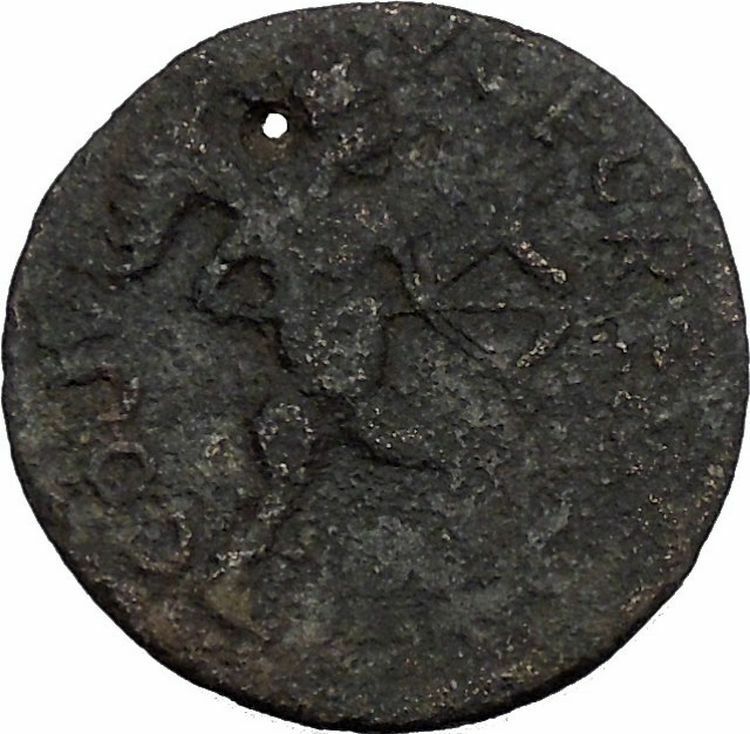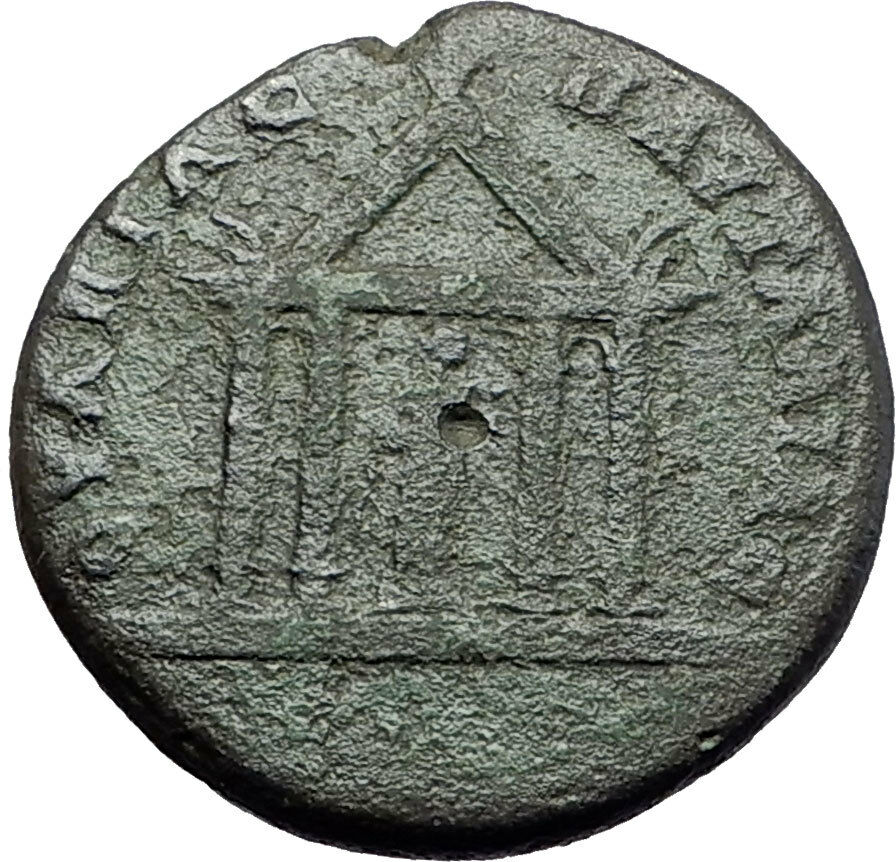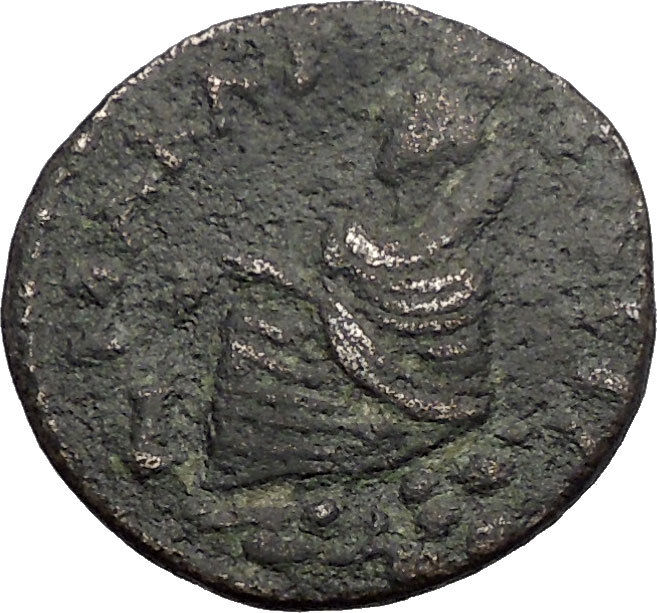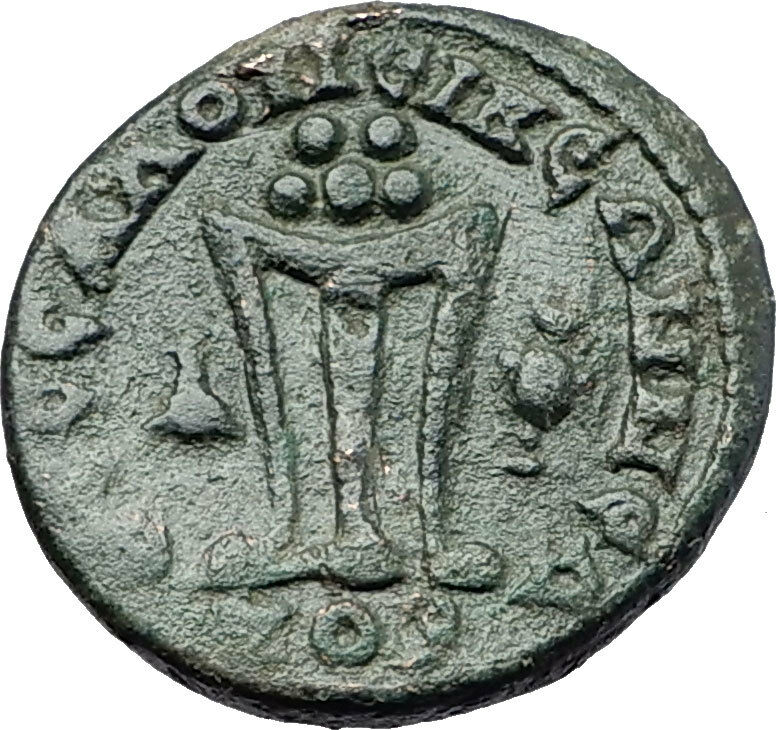|
Nero – Roman Emperor: 54-68 A.D.
Billon Silver Tetradrachm 26mm (11.37 grams)
Struck at city of Alexandria in Egypt Regnal Year 13 = 66/67 A.D
Reference: Köln 191; Dattari (Savio) 255; K&G 14.94; RPC I 5297.
Certification: NGC Ancients Ch VF 4529163-002
NEPΩ KΛAY KAIΣ ΣEB ΓEP AY, Radiate bust of Nero left, wearing aegis; L IΓ (date) below chin.
ΔIOΣ OΛΥΜΠΙΟΥ, Laureate and draped bust of Zeus Olympios right.
* Numismatic Note: Rare depiction of Olympian Zeus, likely the same as from the Olympic games!
You are bidding on the exact item pictured, provided with a Certificate of Authenticity and Lifetime Guarantee of Authenticity.
 The Statue of Zeus at Olympia was a giant seated figure, about 13 m (43 ft) tall, made by the Greek sculptor Phidias around 435 BC at the sanctuary of Olympia, Greece, and erected in the Temple of Zeus there. A sculpture of ivory plates and gold panels over a wooden framework, it represented the god Zeus sitting on an elaborate cedar wood throne ornamented with ebony, ivory, gold and precious stones. One of the Seven Wonders of the Ancient World, it was lost and destroyed during the 5th century AD with no copy ever being found, and details of its form are known only from ancient Greek descriptions and representations on coins. The Statue of Zeus at Olympia was a giant seated figure, about 13 m (43 ft) tall, made by the Greek sculptor Phidias around 435 BC at the sanctuary of Olympia, Greece, and erected in the Temple of Zeus there. A sculpture of ivory plates and gold panels over a wooden framework, it represented the god Zeus sitting on an elaborate cedar wood throne ornamented with ebony, ivory, gold and precious stones. One of the Seven Wonders of the Ancient World, it was lost and destroyed during the 5th century AD with no copy ever being found, and details of its form are known only from ancient Greek descriptions and representations on coins.
Billon is an alloy of a precious metal (most commonly silver) with a majority base metal content (such as copper). It is used chiefly for making coins, medals, and token coins. The word comes from the French bille. The use of billon coins dates from ancient Greece through the Middle Ages. During the 6th and 5th centuries BC, some cities on Lesbos Island used coins made of 60% copper and 40% silver. Billon coins are perhaps best known from the Roman Empire, where progressive debasements of the Roman denarius and the Roman provincial tetradrachm.
Alexandria was founded around a small Ancient Egyptian town c. 331 BC by Alexander the Great. It became an important center of the Hellenistic civilization and remained the capital of Hellenistic and Roman and Byzantine Egypt for almost 1000 years until the Muslim conquest of Egypt in AD 641, when a new capital was founded at Fustat (later absorbed into Cairo). Hellenistic Alexandria was best known for the Lighthouse of Alexandria (Pharos), one of the Seven Wonders of the Ancient World; its Great Library (the largest in the ancient world; now replaced by a modern one); and the Necropolis, one of the Seven Wonders of the Middle Ages. Alexandria was the second most powerful city of the ancient world after Rome.
Alexandria is believed to have been founded by Alexander the Great in April 331 BC. Alexander’s chief architect for the project was Dinocrates. Alexandria was intended to supersede Naucratis as a Hellenistic center in Egypt, and to be the link between Greece and the rich Nile valley. Alexandria was the intellectual and cultural center of the ancient world for some time. The city and its museum attracted many of the greatest scholars, including Greeks, Jews and Syrians. The city was later plundered and lost its significance.

An Egyptian city, Rhakotis, already existed on the shore also, and later gave its name to Alexandria in the Egyptian language. It continued to exist as the Egyptian quarter of the city. A few months after the foundation, Alexander left Egypt and never returned to his city. After Alexander’s departure, his viceroy, Cleomenes, continued the expansion. Following a struggle with the other successors of Alexander, his general Ptolemy succeeded in bringing Alexander’s body to Alexandria, though it was eventually lost after being separated from its burial site there.
Although Cleomenes was mainly in charge of overseeing Alexandria’s continuous development, the Heptastadion and the mainland quarters seem to have been primarily Ptolemaic work. Inheriting the trade of ruined Tyre and becoming the center of the new commerce between Europe and the Arabian and Indian East, the city grew in less than a generation to be larger than Carthage. In a century, Alexandria had become the largest city in the world and, for some centuries more, was second only to Rome. It became Egypt’s main Greek city, with Greek people from diverse backgrounds.
Alexandria was not only a center of Hellenism, but was also home to the largest urban Jewish community in the world. The Septuagint, a Greek version of the Tanakh, was produced there. The early Ptolemies kept it in order and fostered the development of its museum into the leading Hellenistic center of learning (Library of Alexandria), but were careful to maintain the distinction of its population’s three largest ethnicities: Greek, Jewish, and Egyptian.
In AD 115, large parts of Alexandria were destroyed during the Kitos War, which gave Hadrian and his architect, Decriannus, an opportunity to rebuild it. In 215, the emperor Caracalla visited the city and, because of some insulting satires that the inhabitants had directed at him, abruptly commanded his troops to put to death all youths capable of bearing arms. On 21 July 365, Alexandria was devastated by a tsunami (365 Crete earthquake), an event annually commemorated years later as a “day of horror.”
Nero – 54-68 A.D.
Caesar, 50-54 (Under Claudius)
| Son of Agrippina Junior (by Ahenobarbus) | Husband of Claudia Octavia, Poppaea and Statilia Messalina | Father of Claudia Neronis | Adopted son, grand-nephew, and successor of Claudius | Step-brother of Claudia Antonia, Britannicus and Claudia Octavia | Nephew of Caligula | Grandson of Germanicus and Agrippina Senior | Great-grandson of Agrippa, Julia, Nero Claudius Drusus and Antonia |
 Nero (Latin: Nero Claudius Caesar Augustus Germanicus;15 December 37 – 9 June 68) was Roman Emperor from 54 to 68, and the last in the Julio-Claudian dynasty. Nero was adopted by his great uncle Claudius to become his heir and successor, and succeeded to the throne in 54 following Claudius’ death. Nero (Latin: Nero Claudius Caesar Augustus Germanicus;15 December 37 – 9 June 68) was Roman Emperor from 54 to 68, and the last in the Julio-Claudian dynasty. Nero was adopted by his great uncle Claudius to become his heir and successor, and succeeded to the throne in 54 following Claudius’ death.
During his reign, Nero focused much of his attention on diplomacy, trade, and enhancing the cultural life of the Empire. He ordered theaters built and promoted athletic games. During his reign, the redoubtable general Corbulo conducted a successful war and negotiated peace with the Parthian Empire. His general Suetonius Paulinus crushed a revolt in Britain. Nero annexed the Bosporan Kingdom to the Empire and began the First Roman-Jewish War.
In 64, most of Rome was destroyed in the Great Fire of Rome, which many Romans believed Nero himself had started in order to clear land for his planned palatial complex, the Domus Aurea. In 68, the rebellion of Vindex in Gaul and later the acclamation of Galba in Hispania drove Nero from the throne. Facing assassination, he committed suicide on 9 June 68 (the first Roman emperor to do so) His death ended the Julio-Claudian Dynasty, sparking a brief period of civil wars known as the Year of the Four Emperors. Nero’s rule is often associated with tyranny and extravagance. He is known for many executions, including that of his mother, and the probable murder by poison of his stepbrother Britannicus.
He is infamously known as the Emperor who “fiddled while Rome burned” and as an early persecutor of Christians. He was known for having captured Christians to burn them in his garden at night for a source of light. This view is based on the writings of Tacitus, Suetonius, and Cassius Dio, the main surviving sources for Nero’s reign. Few surviving sources paint Nero in a favorable light. Some sources, though, including some mentioned above, portray him as an emperor who was popular with the common Roman people, especially in the East. Some modern historians question the reliability of ancient sources when reporting on Nero’s tyrannical acts.
Family
Lucius Domitius Ahenobarbus, the future Nero, was born on 15 December 37 in Antium, near Rome. He was the only son of Gnaeus Domitius Ahenobarbus and Agrippina the Younger, sister of Emperor Caligula.
Nero’s father Gnaeus was the son of Lucius Domitius Ahenobarbus (consul 16 BC) and Antonia Major. Gnaeus was thus the grandson of Gnaeus Domitius Ahenobarbus (consul 32 BC) and probably Aemilia Lepida on his father’s side, and the grandson of Mark Antony and Octavia Minor on his mother’s side. Thus, Nero had as his paternal grandmother Antonia Maior, and also claimed more remote descent from Antonia Minor as a great-grandson-later grandson after Claudius adopted him.
Through Octavia, Nero was the grandnephew of Caesar Augustus. Nero’s father had been employed as a praetor and was a member of Caligula’s staff when the latter traveled to the East (some apparently think Suetonius refers to Augustus’ adopted son Gaius Caesar here, but this is not likely).
Nero’s father was described by Suetonius as a murderer and a cheat who was charged by Emperor Tiberius with treason, adultery, and incest. Tiberius died, allowing him to escape these charges. Nero’s father died of edema (“dropsy”) in 39 when Nero was two.
Nero’s mother was Agrippina the Younger, a great-granddaughter of Caesar Augustus and his wife Scribonia through their daughter Julia the Elder and her husband Marcus Vipsanius Agrippa. Agrippina’s father, Germanicus, was a grandson of Augustus’s wife, Livia, on one side and to Mark Antony and Octavia on the other. Germanicus’ mother Antonia Minor, was a daughter of Octavia Minor and Mark Antony. Octavia was Augustus’ elder sister. Germanicus was also the adopted son of Tiberius. Agrippina poisoned her second husband Passienus Crispus, so many ancient historians also accuse her of murdering her third husband, the emperor Claudius.
Nero was not expected to become Emperor because his maternal uncle, Caligula, had begun his reign at the age of 25 with enough time to produce his own heir. Nero’s mother, Agrippina, lost favor with Caligula and was exiled in 39 after her husband’s death. Caligula seized Nero’s inheritance and sent him to be raised by his less wealthy aunt, Domitia Lepida, who was the mother of Valeria Messalina, Claudius’s third wife.
Caligula, his wife Caesonia and their infant daughter Julia Drusilla were murdered on 24 January 41. These events led Claudius, Caligula’s uncle, to become emperor. Claudius allowed Agrippina to return from exile.
Claudius had married twice before marrying Valeria Messalina. His previous marriages produced three children including a son, Drusus, who died at a young age. He had two children with Messalina – Claudia Octavia (born 40) and Britannicus (born 41). Messalina was executed by Claudius in the year 48.
In 49 AD, Claudius married a fourth time, to Nero’s mother Agrippina. To aid Claudius politically, young Nero was adopted in 50 and took the name Nero Claudius Caesar Drusus Germanicus . Nero was older than his stepbrother Britannicus, and thus became heir to the throne.
Nero was proclaimed an adult in 51 at the age of 14. He was appointed proconsul, entered and first addressed the Senate, made joint public appearances with Claudius, and was featured in coinage. In 53, he married his stepsister Claudia Octavia.
Nero and Agrippina. Agrippina crowns her young son Nero with a laurel wreath. She carries a cornucopia, symbol of fortune and plenty, and he wears the armour and cloak of a Roman commander, with a helmet on the ground at his feet. The scene refers to Nero’s accession as emperor in 54 AD and is dated before 59 AD when Nero had Agrippina murdered.
Claudius died in 54 and Nero, taking the name Nero Claudius Caesar Augustus Germanicus, was established as Emperor. Though accounts vary, many ancient historians state Agrippina poisoned Claudius. According to Pliny the Elder, she used poison mushrooms. It is not known how much Nero knew or if he was even involved in the death of Claudius.
Suetonius wrote “…for even if he was not the instigator of the emperor’s death, he was at least privy to it, as he openly admitted; for he used afterwards to laud mushrooms, the vehicle in which the poison was administered to Claudius, as “the food of the gods,” as the Greek proverb has it. At any rate, after Claudius’ death he vented on him every kind of insult, in act and word, charging him now with folly and now with cruelty; for it was a favourite joke of his to say that Claudius had ceased “to play the fool among mortals, lengthening the first syllable of the word morari, and he disregarded many of his decrees and acts as the work of a madman and a dotard. Finally, he neglected to enclose the place where his body was burned except with a low and mean wall.”
Nero became Emperor at 17 when the news of Claudius’ death was made known,the youngest emperor until that time. Ancient historians describe Nero’s early reign as being strongly influenced by his mother, Agrippina, his tutor Lucius Annaeus Seneca, and the Praetorian Prefect Sextus Afranius Burrus, especially in the first year. Other tutors were less often mentioned, such as Alexander of Aegae.
Very early in Nero’s rule, problems arose from competition for influence between Agrippina and Nero’s two main advisers, Seneca and Burrus.
In 54, Agrippina tried to sit down next to Nero while he met with an Armenian envoy, but Seneca stopped her and prevented a scandalous scene (as it was unimaginable at that time for a woman to be in the same room as men doing official business). Nero’s friends also mistrusted Agrippina and told Nero to beware of his mother.
Nero was reportedly unsatisfied with his marriage to Octavia and entered into an affair with Claudia Acte, a former slave. In 55, Agrippina attempted to intervene in favor of Octavia and demanded that her son dismiss Acte. Nero, with the support of Seneca, resisted the intervention of his mother in his personal affairs.
With Agrippina’s influence over her son severed, she reportedly began pushing for Britannicus, Nero’s stepbrother, to become emperor. Nearly fifteen-year-old Britannicus, heir-designate prior to Nero’s adoption, was still legally a minor, but was approaching legal adulthood. According to Tacitus, Agrippina hoped that with her support, Britannicus, being the blood son of Claudius, would be seen as the true heir to the throne by the state over Nero. However, the youth died suddenly and suspiciously on 12 February 55, the very day before his proclamation as an adult had been set.
Nero claimed that Britannicus died from an epileptic seizure, but ancient historians all claim Britannicus’ death came from Nero’s poisoning him. Supposedly, he enlisted the services of Locusta, a woman who specialized in the manufacture of poisons. She devised a mixture to kill Britannicus, but after testing it unsuccessfully on a slave, Nero angrily threatened to have her put to death if she did not come up with something usable. Locusta then devised a new concoction that she promised would “kill swifter than a viper.”
Her promise was fulfilled after Britannicus consumed it at a dinner party from water used to cool his wine, which had already been tasted, and succumbed within minutes. After the death of Britannicus, Agrippina was accused of slandering Octavia and Nero ordered her out of the imperial residence.
Matricide and consolidation of power
Over time, Nero became progressively more powerful, freeing himself of his advisers and eliminating rivals to the throne. In 55, he removed Marcus Antonius Pallas, an ally of Agrippina, from his position in the treasury. Pallas, along with Burrus, was accused of conspiring against the Emperor to bring Faustus Sulla to the throne. Seneca was accused of having relations with Agrippina and embezzlement. Seneca succeeded in having himself, Pallas and Burrus acquitted. According to Cassius Dio, at this time, Seneca and Burrus reduced their role in governing from careful management to mere moderation of Nero.
In 58, Nero became romantically involved with Poppaea Sabina, the wife of his friend and future emperor Otho. Reportedly because a marriage to Poppaea and a divorce from Octavia did not seem politically feasible with Agrippina alive, Nero ordered the murder of his mother in 59. A number of modern historians find this an unlikely motive as Nero did not marry Poppaea until 62 .
Additionally, according to Suetonius, Poppaea did not divorce her husband until after Agrippina’s death, making it unlikely that the already married Poppaea would be pressing Nero for marriage. Some modern historians theorize that Nero’s execution of Agrippina was prompted by her plotting to set Rubellius Plautus on the throne. According to Suetonius, Nero tried to kill his mother through a planned shipwreck, which took the life of her friend, Acerronia Polla, but when Agrippina survived, he had her executed and framed it as a suicide. The incident is also recorded by Tacitus.
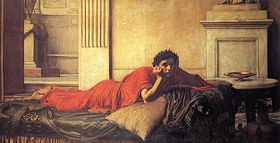
The Remorse of the Emperor Nero after the Murder of his Mother, by John William Waterhouse, 1878.
In 62, Nero’s adviser, Burrus, died. Additionally, Seneca was again faced with embezzlement charges. Seneca asked Nero for permission to retire from public affairs. Nero divorced and banished Octavia on grounds of infertility, leaving him free to marry the pregnant Poppaea. After public protests, Nero was forced to allow Octavia to return from exile, but she was executed shortly after her return.
Nero also was reported to have kicked Poppaea to death in 65 before she could have his second child. However, modern historians, noting Suetonius, Tacitus and Cassius Dio’s possible bias against Nero and the likelihood that they did not have eyewitness accounts of private events, postulate that Poppaea may have died because of complications of miscarriage or childbirth.
Accusations of treason being plotted against Nero and the Senate first appeared in 62. The Senate ruled that Antistius, a praetor, should be put to death for speaking ill of Nero at a party. Later, Nero ordered the exile of Fabricius Veiento who slandered the Senate in a book. Tacitus writes that the roots of the conspiracy led by Gaius Calpurnius Piso began in this year. To consolidate power, Nero executed a number of people in 62 and 63 including his rivals Pallas, Rubellius Plautus and Faustus Sulla. According to Suetonius, Nero “showed neither discrimination nor moderation in putting to death whomsoever he pleased” during this period.
Nero’s consolidation of power also included a slow usurping of authority from the Senate. In 54, Nero promised to give the Senate powers equivalent to those under Republican rule. By 65, senators complained that they had no power left and this led to the Pisonian conspiracy.
Other relationships
When Nero’s wife Poppaea Sabina died in 65, Nero went into deep mourning. Her body was not cremated, it was stuffed with spices, embalmed and put in the Mausoleum of Augustus. She was given a state funeral. Nero praised her during the funeral eulogy and gave her divine honors. It is said that Nero “burned ten years’ worth of Arabia’s incense production at her funeral.
In the beginning of 66, he married Statilia Messalina. She was already married when she became Nero’s mistress in 65 AD, with Statilia’s husband being driven to suicide in 66, so Nero could marry Statilia. She was one of the few of Nero’s courtiers who survived the fall of his reign.
In 67, Nero ordered a young freedman, Sporus, to be castrated and then married him. According to Dion Cassius, Sporus bore an uncanny resemblance to Sabina, and Nero even called him by his dead wife’s name.
Administrative policies
Over the course of his reign, Nero often made rulings that pleased the lower class. Nero was criticized as being obsessed with personal popularity.
Nero began his reign in 54 by promising the Senate more autonomy. In this first year, he forbade others to refer to him with regard to enactments, for which he was praised by the Senate. Nero was known for spending his time visiting brothels and taverns during this period.
In 55, Nero began taking on a more active role as an administrator. He was consul four times between 55 and 60. During this period, some ancient historians speak fairly well of Nero and contrast it with his later rule.
Under Nero, restrictions were put on the amount of bail and fines. Also, fees for lawyers were limited. There was a discussion in the Senate on the misconduct of the freedmen class, and a strong demand was made that patrons should have the right of revoking freedom. Nero supported the freedmen and ruled that patrons had no such right.
The Senate tried to pass a law in which the crimes of one slave applied to all slaves within a household. Despite riots from the people, Nero supported the Senate on their measure, and deployed troops to organise the execution of 400 slaves affected by the law. However, he vetoed strong measures against the freedmen affected by the case.
After tax collectors were accused of being too harsh to the poor, Nero transferred collection authority to lower commissioners. Nero banned any magistrate or procurator from exhibiting public entertainment for fear that the venue was being used as a method to sway the populace. Additionally, there were many impeachments and removals of government officials along with arrests for extortion and corruption.
When further complaints arose that the poor were being overly taxed, Nero attempted to repeal all indirect taxes. The Senate convinced him this action would bankrupt the public treasury. As a compromise, taxes were cut from 4.5% to 2.5%. Additionally, secret government tax records were ordered to become public. To lower the cost of food imports, merchant ships were declared tax-exempt.
In imitation of the Greeks, Nero built a number of gymnasiums and theatres. Enormous gladiatorial shows were also held. Nero also established the quinquennial Neronia. The festival included games, poetry, and theater. Historians indicate that there was a belief that theatre led to immorality. Others considered that to have performers dressed in Greek clothing was old fashioned. Some questioned the large public expenditure on entertainment.
In 64, Rome burned. Nero enacted a public relief effort as well as significant reconstruction. A number of other major construction projects occurred in Nero’s late reign. Nero had the marshes of Ostia filled with rubble from the fire. He erected the large Domus Aurea. In 67, Nero attempted to have a canal dug at the Isthmus of Corinth. Ancient historians state that these projects and others exacerbated the drain on the State’s budget.
The cost to rebuild Rome was immense, requiring funds the state treasury did not have. Nero devalued the Roman currency for the first time in the Empire’s history. He reduced the weight of the denarius from 84 per Roman pound to 96 (3.85 grams to 3.35 grams). He also reduced the silver purity from 99.5% to 93.5%-the silver weight dropping from 3.83 grams to 3.4 grams. Furthermore, Nero reduced the weight of the aureus from 40 per Roman pound to 45 (8 grams to 7.2 grams).
Between 62 and 67, according to Plinius the Elder and Seneca, Nero promoted an expedition to discover the sources of the Nile River. It was the first exploration of equatorial Africa from Europe in history. However, Nero’s expedition up the Nile failed because water plants had clogged the river, denying Nero’s vessels access to the Sudd of Nubia.
The economic policy of Nero is a point of debate among scholars. According to ancient historians, Nero’s construction projects were overly extravagant and the large number of expenditures under Nero left Italy “thoroughly exhausted by contributions of money” with “the provinces ruined.” Modern historians, though, note that the period was riddled with deflation and that it is likely that Nero’s spending came in the form of public works projects and charity intended to ease economic troubles.
Great Fire of Rome (64 AD)
The Great Fire of Rome erupted on the night of 18 July to 19 July 64. The fire started at the southeastern end of the Circus Maximus in shops selling flammable goods.
The extent of the fire is uncertain. According to Tacitus, who was nine at the time of the fire, it spread quickly and burned for over five days. It destroyed three of fourteen Roman districts and severely damaged seven. The only other historian who lived through the period and mentioned the fire is Pliny the Elder, who wrote about it in passing. Other historians who lived through the period (including Josephus, Dio Chrysostom, Plutarch, and Epictetus) make no mention of it in what remains of their work.
It is uncertain who or what actually caused the fire-whether accident or arson. Suetonius and Cassius Dio favor Nero as the arsonist, so he could build a palatial complex. Tacitus mentions that Christians confessed to the crime, but it is not known whether these confessions were induced by torture. However, accidental fires were common in ancient Rome. In fact, Rome suffered another large fire in 69 and in 80.
It was said by Suetonius and Cassius Dio that Nero sang the “Sack of Ilium” in stage costume while the city burned. Popular legend claims that Nero played the fiddle at the time of the fire, an anachronism based merely on the concept of the lyre, a stringed instrument associated with Nero and his performances. (There were no fiddles in 1st-century Rome.) Tacitus’s account, however, has Nero in Antium at the time of the fire. Tacitus also said that Nero playing his lyre and singing while the city burned was only rumor.
According to Tacitus, upon hearing news of the fire, Nero returned to Rome to organize a relief effort, which he paid for from his own funds. Nero’s contributions to the relief extended to personally taking part in the search for and rescue of victims of the blaze, spending days searching the debris without even his bodyguards. After the fire, Nero opened his palaces to provide shelter for the homeless, and arranged for food supplies to be delivered in order to prevent starvation among the survivors.
In the wake of the fire, he made a new urban development plan. Houses after the fire were spaced out, built in brick, and faced by porticos on wide roads. Nero also built a new palace complex known as the Domus Aurea in an area cleared by the fire. This included lush artificial landscapes and a 30-meter-tall statue of himself, the Colossus of Nero. The size of this complex is debated (from 100 to 300 acres). To find the necessary funds for the reconstruction, tributes were imposed on the provinces of the empire.
Tacitus notes that the population searched for a scapegoat and rumors held Nero responsible. To deflect blame, Nero targeted Christians. He ordered Christians to be thrown to dogs, while others were crucified and burned.
|









 The Statue of Zeus at Olympia was a giant seated figure, about 13 m (43 ft) tall, made by the Greek sculptor Phidias around 435 BC at the sanctuary of Olympia, Greece, and erected in the Temple of Zeus there. A sculpture of ivory plates and gold panels over a wooden framework, it represented the god Zeus sitting on an elaborate cedar wood throne ornamented with ebony, ivory, gold and precious stones. One of the Seven Wonders of the Ancient World, it was lost and destroyed during the 5th century AD with no copy ever being found, and details of its form are known only from ancient Greek descriptions and representations on coins.
The Statue of Zeus at Olympia was a giant seated figure, about 13 m (43 ft) tall, made by the Greek sculptor Phidias around 435 BC at the sanctuary of Olympia, Greece, and erected in the Temple of Zeus there. A sculpture of ivory plates and gold panels over a wooden framework, it represented the god Zeus sitting on an elaborate cedar wood throne ornamented with ebony, ivory, gold and precious stones. One of the Seven Wonders of the Ancient World, it was lost and destroyed during the 5th century AD with no copy ever being found, and details of its form are known only from ancient Greek descriptions and representations on coins.
 Nero (Latin: Nero Claudius Caesar Augustus Germanicus;15 December 37 – 9 June 68) was Roman Emperor from 54 to 68, and the last in the Julio-Claudian dynasty. Nero was adopted by his great uncle Claudius to become his heir and successor, and succeeded to the throne in 54 following Claudius’ death.
Nero (Latin: Nero Claudius Caesar Augustus Germanicus;15 December 37 – 9 June 68) was Roman Emperor from 54 to 68, and the last in the Julio-Claudian dynasty. Nero was adopted by his great uncle Claudius to become his heir and successor, and succeeded to the throne in 54 following Claudius’ death.


